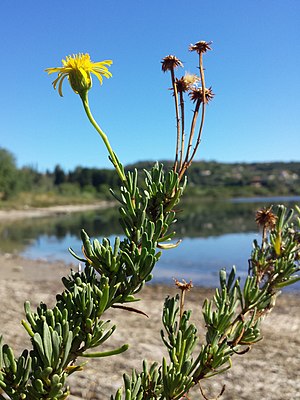Salt elephant
| Salt elephant | ||||||||||||
|---|---|---|---|---|---|---|---|---|---|---|---|---|

Salt elephant ( Limbarda crithmoides ) |
||||||||||||
| Systematics | ||||||||||||
|
||||||||||||
| Scientific name | ||||||||||||
| Limbarda crithmoides | ||||||||||||
| ( L. ) Dumort. |

The golden samphire ( Limbarda crithmoides (L.) Dumort. , Syn .: Inula crithmoides L. ) is a halophytic plant from the family of the daisy family (Asteraceae).
description
The salt elephant is a perennial plant that reaches heights of 10 to 90 cm. The shoots lignified at the bottom are upright or ascending, not very branched and richly leafed. The fleshy leaves are glabrous and linear. They become 2 to 4.5 cm long and 2 to 4 mm wide. They are entire and have three teeth at the tip. In the leaf axils there are cluster-like short shoots.
The flower heads are composed of 5 mm long, orange-yellow tubular flowers and 14 to 25 mm long, yellow ray-flowers , which double over the hemispherical calyx. The outer bracts are linear, upright and 3 to 4 mm long. The inner bracts are linear-sub-like and are 5 to 10 mm long. The head stalks are thickened at the top and have small, linear and pointed bracts. The ribbed fruits have brownish-white, unconnected pappus bristles at the bottom . The fruits become 2 to 3 mm long and are not tapered at the tip.
The flowering period is July to October.
The number of chromosomes is 2n = 18.
Occurrence
The salt elephant is widespread along the coasts of the entire Mediterranean and Western Europe, north to England and Ireland. It is also widespread inland in eastern Spain and North Africa. Sandy beaches, coastal cliffs and salt marshes are preferred as locations.
Systematics
The salt elephant was first published in 1753 by Carl von Linné in Species Plantarum under the basionym Inula crithmoides . In 1827, Barthélemy Charles Joseph Dumortier published Limbarda crithmoides . This name was taken up again in a cladistic study published by Arne Anderberg in 1991 , in which the salt elephant was separated from the genus Inula .
The salt elephant is divided into two geographically separate subspecies:
- Limbarda crithmoides (L.) Dumort. subsp. crithmoides : It represents the species on the Atlantic coast of Spain, France, England and Ireland.
- Limbarda crithmoides subsp. longifolia (Arcang.) Greuter : With elongated, pointed leaves compared to the nominotypical subspecies. This subspecies is widespread on the Mediterranean coasts and is also found in Portugal.
swell
literature
- Peter Schönfelder, Ingrid Schönfelder: What is in bloom in the Mediterranean? 750 species (= Kosmos nature guide ). 4th edition. Franckh-Kosmos, Stuttgart 2005, ISBN 3-440-10211-4 .
Individual evidence
- ^ A b Werner Greuter, Eckhard von Raab-Straube (Ed.): Med Checklist. A critical inventory of vascular plants of the circum-Mediterranean countries . Vol. 2: Dicotyledones (Compositae) . Organization for the Phyto-Taxonomic Investigation of the Mediterranean Area (OPTIMA), Genève 2008, ISBN 978-2-8279-0011-4 , pp. 540 .
- ↑ a b c Werner Greuter: The Euro + Med treatment of Gnaphalieae and Inuleae (Compositae) - generic concepts and required new names. In: Willdenowia. Volume 33, No. 2, 2003, pp. 239-244, DOI: 10.3372 / wi.33.33202 .
- ↑ Peter Schönfelder , Ingrid Schönfelder: The new cosmos Mediterranean flora. Franckh Kosmos Verlag Stuttgart 2008. ISBN 978-3-440-10742-3 . P. 116.
- ↑ Inula crithmoides at Tropicos.org. In: IPCN Chromosome Reports . Missouri Botanical Garden, St. Louis
- ↑ Carl von Linné: Species Plantarum. Volume 2, Lars Salvius, Stockholm 1753, p. 883, digitized .
- ^ Barthélemy C. Dumortier: Florula Belgica, operis maioris prodromus. J. Castermann, Tournay 1827, p. 68 in the Google book search.
- ^ Arne A., Anderberg: Taxonomy and phylogeny of the tribe Inuleae (Asteraceae). In: Plant Systematics and Evolution. Volume 176, No. 1-2, 1991, pp. 75-123, DOI: 10.1007 / BF00937947 .
- ^ Werner Greuter : Compositae (pro parte majore). In: Werner Greuter & Eckhard von Raab-Straube (eds.): Compositae. Euro + Med Plantbase - the information resource for Euro-Mediterranean plant diversity. 2006–2009, online .
- ^ Giovanni Arcangeli: Compendio della flora italiana; ossia, Manuals per la determinazione delle piante che trovansi selvatiche od inselvatichite nell'Italia e nelle isole adiacenti. E. Loescher, Torino 1882, p. 371 .
Web links
- Inula crithmoides near Tela Botanica , with photos of both subspecies.
- Thomas Meyer, Michael Hassler: Mediterranean and Alpine flora. [1]
- Distribution in the British Isles
